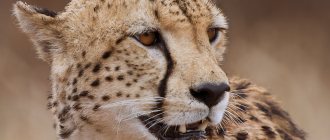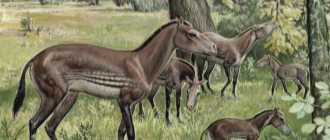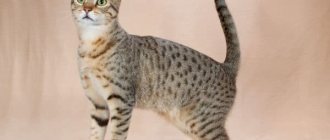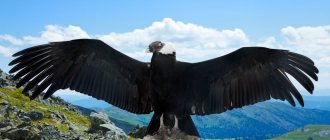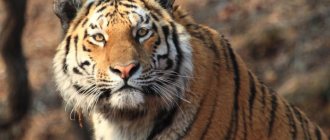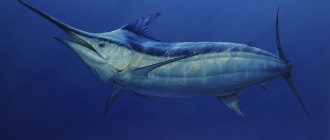Dune cat
The sand cat is the smallest representative of wild cats, and therefore is often endangered by other predators. Capable of chasing prey at a speed of 40 km/h for 10 km.
Egyptian Mau
Although the Egyptian Mau has long been domesticated, the wild nature of the cat still takes over. From the time when her ancestors had to hunt for survival, Mau learned to run at a speed of 58 km/h.
Leopard
For him, high speed is not particularly important, since he does not hunt on the ground. This spotted wild cat prefers to watch for prey, hiding in the foliage of trees, and overtake it with one sharp jump. He has strong muscular legs, and his running speed can reach 60 km/h.
Tiger
A very large cat, capable of chasing prey at speeds of 60 km/h. But a weight of more than 300 kg and a 3-meter body length often interfere with successful hunting.
Puma
Like the lion, its close relative is large in size, but is capable of maintaining a speed of 75 km/h. This gives the puma an advantage during hunting, but its large dimensions do not allow it to maintain speed for a long time.
Snow Leopard
The handsome snow leopard can only be found high in the mountains. He not only runs fast, but also jumps. The length of his jump can be 6 meters and the height - 3 meters. In terms of running speed, the leopard is not inferior to the lion, while the animal’s long tail acts as a steering wheel and helps to turn in different directions.
a lion
The king of beasts is a fairly large animal with a body weight of more than 2 centners. Therefore, it is difficult for him to maintain high speed over long distances. At a speed of about 80 km/hour, a lion can run no more than 20 meters. When hunting, this predator prefers to lie in wait for its prey and pounce on it.
Panther
The panther is not only fast, but also the most dexterous and dangerous predator.
This wild cat is unusually graceful and, unlike its counterparts, hunts near human settlements. The black beauty is capable of running at a speed of 88 km/h and is particularly bloodthirsty. The objects of her hunt can be not only animals, but also humans.
Jaguar
This animal can move at a speed of 90 km/hour. Jaguars are large. The body, without a tail, can reach a length of more than 2 meters. Because of their size, it is quite difficult for them to pursue prey at high speed for a long time.
Cheetah
Considered the fastest animal on Earth. A wild cat has a powerful, muscular body without an ounce of excess fat. The weight of a cheetah is 70 kg, and the speed that the animal develops exceeds 110 km/h.
The predator will not sit in ambush and guard the prey. The cheetah needs a few tugs and the prey will be in its claws. Just two seconds are enough for this “savage” to develop lightning speed, and the length of the jump can reach 8 meters.
Siamese cat
Siamese cats are playful, active, sometimes noisy and quite demanding. Their cheerful intelligence allows them to do many complex things, such as turning on faucets, switching lights, and opening cabinets. To keep her entertained, you'll have to give her puzzle toys, exercise, and maybe even agility training.
Egyptian Mau
The fastest representatives of domestic cats are considered to be the Egyptian Mau (“Mau” means cat). The maximum record of these miniature darlings is acceleration to 58 km/h (over short distances). All zoologists claim that if these animals had larger dimensions, they could well compete with the cheetah for the title of the fastest animal on the planet.
Black Panther | Speed up to 88 km/h
The black panther opens the top three fastest felines. The maximum recorded speed that a cat can accelerate to is 88 km/h. In addition to speed, panthers also stand out because they are considered the most dangerous predators on the planet. They are very bloodthirsty, and when hungry they can attack any living creature, including humans. The animal is inherently fearless: unlike other predators, they are not used to hiding when they see people. On the contrary, the panther tries to settle as close to human habitation as possible. Not a single case of attack on a person is known.
The fastest breeds of domestic cats
Most domestic cats run faster than humans. Some of them are capable of reaching speeds of up to 45 km/h.
Most often, running speed depends on the body features inherent in a particular breed. Fast domestic cat breeds include:
Oriental
The Oriental is an elegant cat breed devoted to one person. To be completely happy, they need races, physical exercise and active games. If an Oriental is kept indoors, it will have fun making a mess.
Siamese cat
The Siamese cat is always active and can make too much noise. Her restless temperament allows her to play pranks in several places at the same time.
It is important for the owner to know that Siamese dogs benefit from physical exercises for speed and agility.
Manx
Manx is one of the most ancient breeds. They differ from their counterparts by having a short or completely absent tail. Cats of this breed show excellent results in agility and speed.
Ocicat
The Ocicat is a muscular descendant of Abyssinians, Siamese and American Shorthairs. In addition to his athletic build, he is known for his speed and agility. Cats of this breed are very sociable and attached to their owner.
Savannah
Savannah is a close relative of the wild serval. Cats of this breed are very smart, curious and energetic. From their wild ancestors they inherited the ability not only to run fast, but also to climb to great heights.
Bengal
Bengal will never get bored and will not let its owner do so. An extremely active breed, and also a keen climber. If your Bengal cat is out of sight, you should pay attention to the top of the room. She will definitely be there.
Somali cat
The Somali cat is a long-haired version of the Abyssinian. It has a muscular body and well-developed limbs. Shows high ability to train and perform tricks.
Armament
Preserved copy at the exhibition
The Tiger's armament consisted of a cannon and two machine guns - a front-mounted machine gun and a turret-mounted one, coaxial with the gun. Later, mortars appeared that made it possible to create a smoke screen or hit nearby infantry with fragmentation grenades.
A gun
The main weapon of the tank is a KwK 36 L/56 rifled gun with a caliber of 88 mm. The barrel length was 56 calibers. Thanks to the hydraulic drive, the gun could fire in a complete circle in the horizontal plane. The vertical guidance range varied from -8 to +15 degrees.
The destruction range was 4 km, with the advent of the new TZF 9b monocular sight - 5 km. The ammunition consisted of 92-94 shells. Since 1945, this figure has been increased to 120 ammunition.
Machine guns
The Tigers had two, less often three, MG-34 machine guns. On later models, its modifications were used - 34/40, 34/S, 34-41. Firing from the front machine gun was carried out by the radio operator, and from the coaxial machine gun by the gunner. The destruction range is up to 1200 m, the total ammunition load is 4500 rounds.
Smoke grenade launchers
S-type anti-personnel mortars were used as grenade launchers. in addition to creating smoke screens, they fired fragmentation grenades to a height of 5-7 meters. The explosion at such a height hit the infantry surrounding the tank.
Tiger
The tiger has also long been on the list of the fastest representatives among predatory cats. At short distances, it is capable of reaching speeds of up to 60 km/h. Just imagine that in pursuit of a victim they will be able to jump 5-6 meters in length (and in height, by the way, too).
But, even despite these physical abilities, not every tiger hunt is successful. These cats are very massive, their weight can increase up to 300 kg, and their body length (excluding the tail) can vary up to three meters. That is why, despite their physical dominance, they are significantly inferior to the cheetah in speed.
Common types
There are 9 subspecies of the tiger, three of which are now completely exterminated.
Amur tiger (Panthera tigris altaica)
Known as Ussuri, Siberian, Manchurian or North Chinese, it is common in the Amur region, Primorsky and Khabarovsk territories of Russia. The population size reaches about 500 individuals.
Amur (Ussuri) tiger
The Amur tiger is a large subspecies. It is distinguished by thick, long and fluffy wool, light color and many stripes.
Bengal tiger (Panthera tigris tigris)
Bengal tiger (Panthera tigris tigris)
The nominate subspecies that lives in Pakistan, India, Bangladesh, Nepal, Bhutan, Myanmar. The population is estimated at 3100-4500 animals, but it is still under threat due to poaching. The average weight of males is 205-227 kg, for females - 140-150 kg.
Indochinese tiger (Panthera tigris corbetti)
Indochinese tiger (Panthera tigris corbetti)
Distributed in Cambodia, Myanmar, southern China, Laos, Thailand, Malaysia and Vietnam. The number of individuals is 1200-1800. This subspecies is distinguished by a darker color. The average weight of males is from 150 to 190 kg; for females this figure is in the range of 110-140 kg.
Malayan tiger (Panthera tigris jacksoni)
Malayan tiger in a large zoo
Distributed only in the south of the Malay Peninsula. Previously, the population of this subspecies was classified as Indochinese tigers, but according to genetic studies, at the beginning of the 21st century it was separated into an independent subspecies. Its population is estimated at 600-800 individuals, that is, it is the third largest in nature.
Sumatran tiger (Panthera tigris sumatrae)
Sumatran tiger (Panthera tigris sumatrae)
An inhabitant of the Indonesian island of Sumatra, where there are about 400-500 animals. This is the smallest of all subspecies: males weigh 100-130 kg, females weigh 70-90 kg.
Chinese tiger (Panthera tigris amoyensis)
Chinese tiger lies
This small subspecies is the most endangered species. Body length is 2.2-2.6 meters, weight of males is 127-177 kg, females - 100-118 kg. Currently, 59 individuals are kept in captivity in China, and they are trying to introduce them into the wild.
Sixth place – Puma
The predator runs very quickly over short distances. The animal is capable of reaching speeds of up to 75 km/h. That is, a cougar can even catch up with a car that is not going too fast.
In the United States of America, the cougar is commonly called the “mountain lion.” The name is associated with the animal's habitat. The predator can be found not only in forests, but also in the mountains. Moreover, the puma is found even in the jungle and swamps.
Differs in large sizes. Together with the tail, the body reaches 2 meters in length. At the same time, the weight is not too large - from 50 to 100 kg. Much depends on gender and individual characteristics. Due to its well-developed muscles and light weight, the Puma is able to run quickly and hunt deftly.
What do they eat?
The diet of tigers is based on large ungulates: deer, roe deer, tapirs, moose, bantengs. Predators can also hunt small animals and birds.
Tigers are good swimmers. On occasion, they happily eat fish and turtles, and occasionally attack small crocodiles.
In the absence of prey, the predator does not suffer from forced starvation, since it has a certain reserve of subcutaneous fat. The thickness of the fat layer can reach 3-5 cm.
Savannah
The Savannah is a cross between a domestic cat and a Serval, a medium-sized African cat with large ears. Savannah will climb as high as she can, and her long body and legs allow her to reach not only great heights, but also great speeds. The breed is also known for its curiosity, keen intelligence and energy.
Puma
The puma (or mountain lion) consistently occupies sixth position in the world top of the fastest cats. These predators reach speeds of up to 75 km/h over short distances.
These large animals reach two meters in length (including tail). The weight of these cats reaches 100 kg. A well-developed muscular system and low weight contribute to the speed and agility of mountain lions. They can accelerate to 75 km/h.
Females are smaller in size than males. But, at the same time, they are not inferior to them in agility and speed.
Bengal cat
Bengals love to play and enjoy any activity. They are also very demanding of your attention and will do whatever it takes to get it. Your Bengal will easily find a way to climb to the highest point in your house, he will enjoy games and activities, and he will definitely not sit on your lap all day.
The fastest cats in the world
Wild cats are fast and agile animals that are excellent hunters. Even a domestic cat can run at a speed of 40 km per hour. The pet will not be able to cover a long distance at this pace. He will be able to make a tiny leap. Wild cats have greater endurance, so they are able to run at high speed for much longer.
When measuring indicators, the distance and time it takes the animal to cover the distance are taken into account. There are many cats in nature that are capable of running with incredibly high agility.
Armor protection
To protect the tank, chrome-molybdenum rolled armor with surface hardening was used. Its thickness had the following indicators:
- upper front plate of the hull - 100 mm, 8 degrees of inclination;
- average frontal - 63 mm, 10 degrees;
- lower frontal - from 100 mm at 21 degrees of inclination with a transition to 80 mm at a bevel of 66 degrees;
- hull sides - 80 and 63 mm at the top and bottom at zero inclination;
- rear part - 80 mm with an inclination of 8 degrees at the top and 48 at the bottom.
The bottom of the hull had a thickness of 28 mm, the roof was initially 26 mm, in 1944 both indicators increased to 40. The frontal armor of the turret was 100 mm, the sides and rear were 80, and the slopes were zero. The gun mantlet varied from 90 to 200 mm.
The fastest cats
What helps the fastest cats run
Among purebred cats, the Egyptian Mau is considered the record holder for speed. He was lucky with the structure of his hind legs, which have leathery folds at the base. Due to them, while running, the step reserve and amplitude of movements increase, and therefore the speed increases.
The normal speed of cats (on average) is 13.5-13.8 km/h. If a cat moves at a leisurely trot, then it will barely overtake a walking person, and its speed will be about 8 km/h. Whereas the maximum speed of cats is 50 km/h.
Snow Leopard
This top is completed by the snow leopard. They are capable of jumping over a distance of 6-7 meters (the height of the jump reaches 3 meters). The leopard has short, but muscular and strong legs and a fairly long tail, which is necessary to maintain balance during a sprint. By the way, the maximum speed of this representative of the cat family can reach 80 km/h. The snow leopard is the highest mountain animal among all the inhabitants on the planet.
The first position in the ranking is still occupied by the cheetah. This spotted hunter is capable of reaching a speed of 112 km/h. in just 3 seconds. The maximum speed reaches 130 km/h. The length of one jump of this predatory cat can reach 7-8 meters. In addition, the cheetah is able to change the trajectory of its movement almost at lightning speed. That is why the victim has virtually no chance to escape the attack.
- Author: iarriba
Rate this article:
- 5
- 4
- 3
- 2
- 1
(36 votes, average: 3.9 out of 5)
Share with your friends!
Reproduction and care of offspring
Sexual maturity of male tigers occurs at the age of 4-5 years, females are ready to continue the race, reaching 3-4 years of age. These predators are polygamous; one male can have up to 3-5 partners during the mating season, while females mate with only one male.
Male and female meet only during the mating period
Tiger mating season
These predators can breed all year round, but the mating period usually falls in the winter months - December-January. Females signal their readiness to become mothers by leaving urine marks, which males use to find their chosen ones. If the tigress fails to become pregnant during the mating season, she will go into estrus again after a month or two.
Fights rarely arise between males for females, because they mate with tigresses living in their territory. But sometimes young tigers, who have not yet had time to acquire their own “harem,” lay claim to the female, and then the males, in a duel, find out which of them will get the striped lady.
MegaMix
Domestic cats run somewhat slower than homeless cats, for whom speed and lightning speed of reaction are a way of survival. But even at home, they need active movement, so even without visible danger, the cat likes to stretch its muscles, rushing from room to room. In such games, she seems to be chasing imaginary prey. The average speed of the animal, regardless of its habitat, is 13.86 m/s. Even the most unprepared cat runs much faster than a human thanks to a special running technique.
Maximum and average speed
| average speed | Maximum speed | |
| 13.86 m/s | 50 km/h | up to 58 km/h (home) |
In case of danger, she lunges, arches her back and makes jumps that exceed the length of her own body up to 6 times. The front and hind legs work in pairs. When jerking, the animal pushes off the surface with its hind legs, landing first on the front, then on the back pair of legs. When walking leisurely, a cat steps on the pads, but when running, the cat's claws extend outward, which provides better traction on the surface for effective pushing.
Features of running cats and cats of different breeds
Maine Coon cats use their fluffy tail, which has strong muscles at the base, to regulate speed. The bobtail cat breed cannot boast of a powerful tail, as this limb is practically absent. They develop high speed thanks to their high and strong hind legs. This variety is considered one of the most energetic cat breeds; the bobtail needs long active games and requires an equally active lifestyle of the owner.
The leader in terms of speed among domestic cats is the Egyptian Mau breed. At the base of their hind legs they have folds of skin in the form of small bags. The resulting step reserve allows the cat to have a particularly wide range of motion when running and, therefore, to run faster than its relatives from other breeds.
The cat is the victim, the cat is the hunter
Since cats do not occupy a dominant position in the food chain, in the wild they often find themselves in the role of prey and her life depends on how quickly she manages to escape. In its own hunt, this small predator usually focuses on surprise and dexterity of the paws, rather than speed. Having previously hidden and accurately calculated its death-carrying throw, a cat is able to catch a mouse or bird even in flight.
Speed is an advantage, but not an option
However, with all its sprinting qualities, which allow the cat to reach speeds of up to 50 km/h, the cat’s heart is not able to withstand prolonged stress. After a long run at high speed, the cat is forced to stop to normalize its body temperature and breathing. Therefore, when the pursuit is too long, the animal will have to give up. A cat driven by a pack of dogs is doomed to death if it has nowhere to hide.
In urban conditions, where there is not always a suitable tree to climb and avoid danger, these animals die more often than in rural areas.
